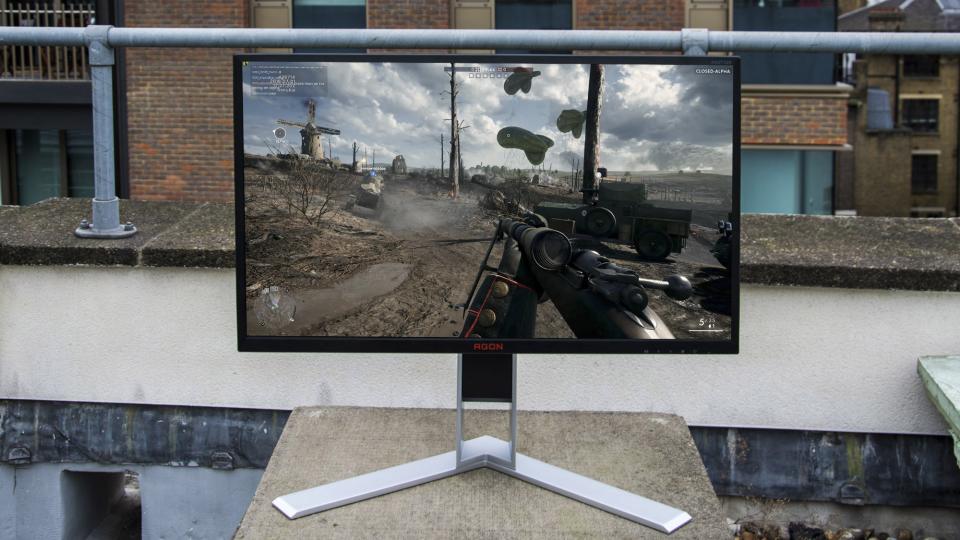
Looking for a new gaming monitor? Here are our top recommendations for 2020
If you’ve been looking for the best gaming monitors, you’ll no doubt have realised how vast the market is. Monitors don’t launch with the frequency of smartphones or laptops, but with countless manufacturers vying for your attention, it’s easy to start believing that the best gaming monitor for you is the one that just happens to catch your eye.
To make matters worse, the world of gaming monitors is a complicated place. You’ll need to match the monitor to your system, whether you’re a PS4, Xbox or gaming PC fanatic. It’s all too easy to buy the first cheap monitor you see, only to find that doesn’t make the most of your amazing graphics card or your Xbox One X’s 4K prowess.
Fortunately, we’re here to help. Below, you’ll find our pick of the best gaming monitors of 2020: we’ve tested as many 1080p, 1440p, 4K and Ultrawide gaming monitors as our eyes could stomach, taking into consideration models of varying price and specification to offer you the best possible spread of top gaming monitors to browse.
If you’re not sure where to begin, you’ll find our guide to buying the best gaming monitor for you immediately below. If you’re already clued-in on the fundamentals of PC monitors, however, you can skip to our recommendations using the following link.
How to choose the best gaming monitor for you
Here are the most important things to consider before you buy a gaming monitor.
Picking a resolution
The resolution of the monitor you choose will depend entirely on the hardware you own.
A PS4 Slim or Xbox One S will only support gaming at Full HD (1,920 x 1,080), although the Xbox One S can run games in HDR and play 4K Blu-ray discs, so you may still benefit from a 4K monitor – if you can afford it.
The PS4 Pro and Xbox One X both support up to 4K (3,840 x 2,160) resolutions, meaning you can splash out on a 4K screen and enjoy the benefits of gaming on it. With all games consoles, there’s little point purchasing a Quad HD (2,560 x 1,440) monitor, as none of the above machines will make good use of it.
A gaming PC isn’t quite as straightforward. The resolution you can play at is tied chiefly to the graphics card you choose, which makes it hard for us to definitively offer a recommendation. As a rule of thumb, Quad HD (2,560 x 1,440) is widely accepted to be the sweet spot for PC gaming, but we would always suggest buying a lower-resolution monitor with a higher refresh rate if you can. Here’s why.
Refresh rate vs frame rate: a quick explainer
For the unaware, a frame is a still image. To create what you see on your gaming monitor, your PC combines a number of these still images (each one a little different to the last) into a virtual slide-show, to give the impression of fluid movement. The number of still images that your computer can combine in a second (whilst running a game, say) is known as the frame rate, which is measured in frames per second (fps). This is one half of the equation.
All monitors, meanwhile, have a refresh rate. This is a measurement in Hertz (Hz) of the number of times the monitor can refresh or “redraw” the entire screen – in order to display something new – per second. This is the other half of the equation.
Basically, the refresh rate of a monitor is equal to the number of frames per second – being pumped out by your gaming PC – that monitor can display.
So let’s say you have a 60Hz monitor, and a gaming PC powerful enough to run your favourite game at 120fps consistently (lucky you). The 60Hz monitor physically cannot refresh its entire screen fast enough to show all 120 frames per second being pumped out by your beefy PC (hence “60Hz”), so you’re essentially not seeing 60 of the available frames.
It’s not technically a limit, because your PC is still outputting 120fps, and your monitor isn’t affecting that capability in any way – it just can’t show all 120 frames. This is why you might experience what is known as screen tearing – more on that below. Got it?
So what’s the big deal?
In short, the faster the refresh rate of your monitor, the smoother the gameplay will feel. Imagine a flip-book: the faster the pages flick by, the more fluid the animation appears. The same principle applies here.
You want a monitor with as high a refresh rate as you can afford; 60Hz is an acceptable minimum but if you have a powerful graphics card, consider increasing that to 144Hz. The current sweet spot for gaming monitors is Quad HD (2,560 x 1,440), 144Hz. There are monitors that refresh at 200Hz and even 240Hz, but you’ll pay through the nose for the privilege.
Nvidia G-Sync and AMD FreeSync
As I mentioned earlier, screen tearing might occur when your gaming PC is pumping out more frames per second than your monitor can display. Nvidia G-Sync and AMD FreeSync are two similar technologies designed to prevent screen tearing by syncing the refresh rate of your monitor with the frame rate being outputted by your gaming PC.
AMD’s FreeSync is found on most cheaper monitors, while only a selection of monitors are compatible with Nvidia G-Sync (you can find a list here). Both technologies are compatible with both AMD and Nvidia graphics cards. We actually have an entire article dedicated to explaining the differences between G-Sync and FreeSync, if that sort of thing interests you…
Response time
You want to look for a panel with the lowest possible response time – quoted response times from manufacturers are G2G (grey-to-grey), with 1ms the fastest achievable time. Response times are most commonly tied to the type of panel that you choose.
Panel type
There are three main types of monitor panel. Each one is a form of either LCD or LED display and as such will give you a good idea of the pros and cons of both technologies.
TN panels have a fast response time, but poor colour accuracy and a tendency to suffer from rubbish viewing angles. You’ll tend to find these on cheaper monitors, as they are relatively inexpensive to produce.
IPS/PLS panels are known for their colour accuracy and slower response times. You’ll find these on more expensive monitors, such as those used for professional photo editing, but also on high-end gaming monitors.
VA panels are the best for colour accuracy, and the worst for response times. You won’t find many gaming monitors with VA panels.
For what it’s worth, there are plenty of games out there that don’t require super high response times, and as such, don’t limit your search to TN if you can afford a vibrant IPS panel. Unless, of course, you’re a pro gamer who loves a good first-person shooter.
Input lag
This is the time it takes for an input (such as your mouse) to be registered on your monitor. This is never quoted by manufacturers and is a little hard to test, but it’s a crucial spec for competitive gamers. Like response times, however, input lag isn’t something the average gamer should tie him/herself in knots over.
Design and build quality
This is pretty simple stuff. Cheap monitors will often offer minimal adjustment options – they will cut out height and swivel adjustments and leave you with only the option to tilt your screen forward and back. Not super useful if you care about good posture (which you should).
You might also check whether your chosen monitor has a VESA mount if you’re creating a dual monitor setup and want to mount both on a single central stand.
In addition, it’s worth looking at the simple things, like how many/what kind of ports the monitor has, what the OSD (onscreen display, or settings menu) is like and how much assembly is required.
The best gaming monitors to buy
1. Samsung Odyssey G7: The best gaming monitor
Price: 27in, £548; 32in, £622 | Buy now from Amazon
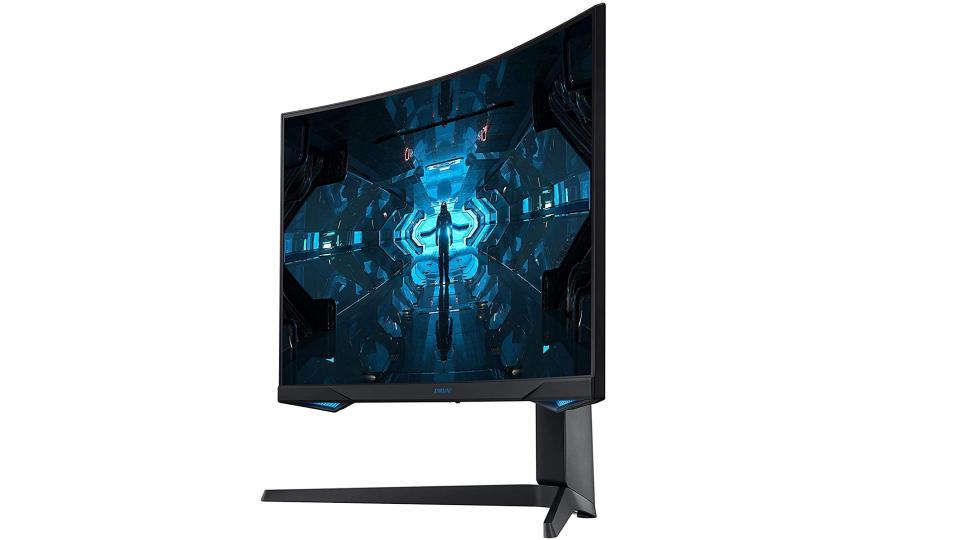
Samsung’s latest 1440p gaming monitor is an absolute cracker. Its VA panel has a refresh rate of 240Hz and a grey-to-grey (GTG) response time of 1ms, and it’s as smooth and blur-free as any monitor you’ve ever seen. It supports HDR10 600, and AMD FreeSync and it’s compatible with Nvidia G-Sync. Games look utterly wonderful on this thing and, if you have a powerful enough GPU they run without stuttering or tearing.
The Odyssey G7’s best feature, however, is its dramatic 1000R curvature, which wraps around your field of vision and puts you right at the heart of the action. It’s an unbelievably good gaming monitor and, best of all, not particularly expensive, especially at the 27in size. If you can afford one, and your PC is powerful enough to run games at 1440p, go buy one now.
Read our full Samsung Odyssey G7 review
Key specs – Screen size: 27in, Resolution: 2,560 x 1,440, Screen technology: IPS, Video inputs: DVI, HDMI (1.4 MHL and 2.0), DisplayPort 1.2, Refresh rate: 144Hz; Response time: 4ms
2. AOC G2260VWQ6: The best budget gaming monitor
Price: £125 | Buy now from Laptops Direct

This small AOC gaming monitor is perfect for those on a tight budget. It has a 21.5in TN display that runs Full HD at 75Hz with support for AMD FreeSync.
Its key selling point is a superfast response time and low input lag, although don’t expect magnificent colours or viewing angles. Elsewhere, its fixed stand only provides tilt adjustment. If you were in the market for something a little bigger, consider the Iiyama GB2530HSU-B below.
Key specs – Screen size: 21.5in; Resolution: 1,920 x 1,080; Screen technology: TN; Video inputs: DisplayPort, VGA, HDMI; Refresh rate: 75Hz; Response time: 1ms
3. Iiyama GB2530HSU-B1: The best 1080p gaming monitor
Price: £130 | Buy now from Amazon

If you’re looking for a slightly larger screen, the GB2530HSU-B1 is the best gaming monitor you can find for under £125. It features a 24.5in Full HD (1,920 x 1,080) TN panel, which is both ultra-responsive and has a perceivably low input lag. Coupled with a 75Hz refresh rate and AMD FreeSync, the panel provides a fluid, tear-free gaming experience, although you will need a compatible AMD graphics card.
But that’s not all: it has a sublime design with its three-sided borderless bezels, a stand that allows tilt and even has built-in speakers for those pesky Windows notifications. For a TN panel, it has a respectable contrast ratio and vibrant colours, which puts it above the AOC equivalent, the G2460VQ6.
Read our full Iiyama GB2530HSU-B1 review for details
Key specs – Screen size: 24.5in; Resolution: 1,920 x 1,080; Screen technology: TN; Video inputs: DisplayPort, VGA, HDMI; Refresh rate: 75Hz; Response time: 1ms
4. Acer Nitro VG270UP: The best 144Hz gaming monitor
Price: £380 | Buy now from Amazon
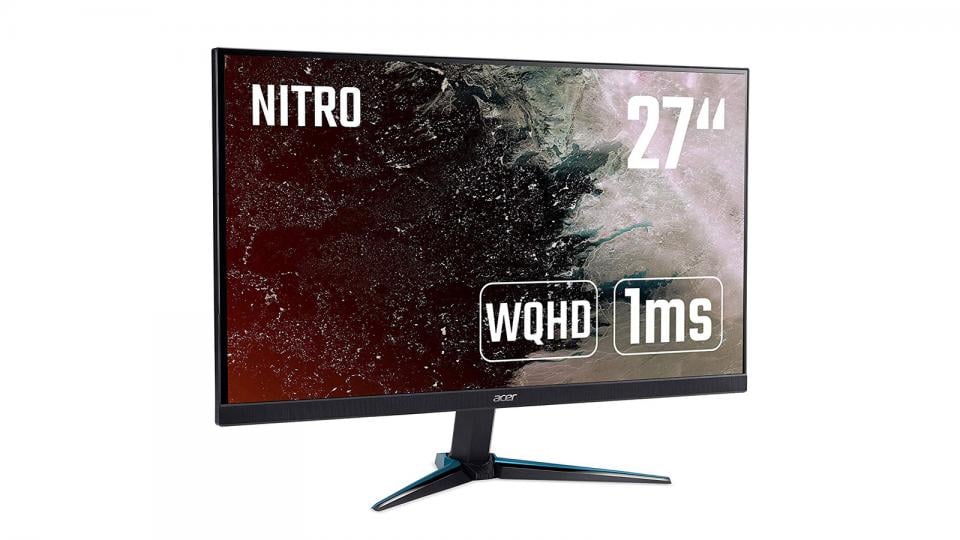
If you can’t quite afford Acer’s XF270HUA, the Acer Nitro VG270UP is an excellent alternative. It has near-identical specs: a 27in IPS panel that runs up to 144Hz at 1440p and, with the aid of Visual Response Boost (VRB), has a quoted response time of 1ms. However, the latter only runs at 120Hz and limits the monitor’s peak brightness.
What makes this stand out from other sub-£400 monitors is its ability to blend pinpoint colour accuracy with a responsive panel – it’s suitable for competitive games. Indeed, its IPS panel is a sight to behold and is among the most colour accurate monitors we’ve ever come across. The only real catch is its flimsy non-adjustable stand, brightness uniformity and ghosting on the highest overdrive setting.
Read our full Acer Nitro VG270UP review for details
Key specs – Screen size: 27in; Resolution: 2,560 x 1,440; Screen technology: IPS; Video inputs: 2 x HDMI, DisplayPort; Refresh rate: 144Hz; Response time: 1ms (with VRB)
5. ViewSonic XG2530: The best gaming monitor for eSports
Price: £393 | Buy now from Amazon
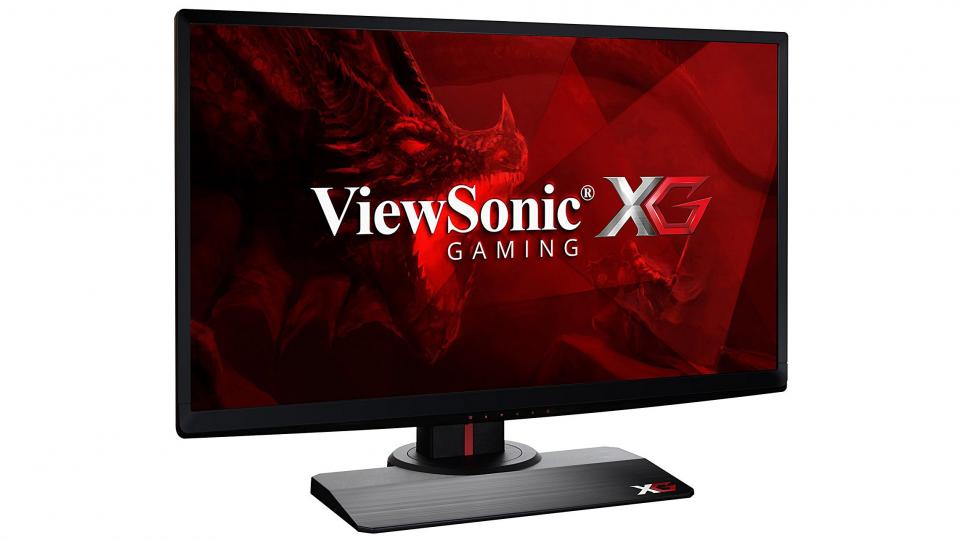
The ViewSonic XG2530 is one of the most impressive 240Hz gaming monitors on the market. It’s a 25in monitor with a TN panel that has a quoted 1ms G2G response time. Its gaming performance is fantastic – with the panel’s response time aided by the “Rampage Response” on the Fastest setting, the monitor can be used for competitive gaming. Thankfully, this doesn’t add any unwanted inverse ghosting to the overall image. Input lag isn’t as low as some of the best gaming monitors on the market, but it’s acceptable.
Image quality is good for a gaming monitor. Colours are vibrant, full of life and aren’t overly washed out like most TN panels. It has a good level of saturation, colour accuracy and overall brightness uniformity. If you’re looking for an impressive 240Hz monitor that doesn’t suffer from frame-skipping, get the XG2530. Alternatively, consider the vastly impressive Acer Predator XB241H instead. The latter runs 180Hz at 1080p and features Nvidia’s G-Sync module.
Read our full ViewSonic XG2530 review for details
Key specs – Screen size: 25in; Resolution: 1,920 x 1,080; Screen technology: TN; Video inputs: DisplayPort 1.2, HDMI 2.0, HDMI 1.4; Refresh rate: 240Hz; Response time: 1ms
6. Samsung CHG70 (C27HG70): The best curved gaming monitor
Price: £416 | Buy now from AO
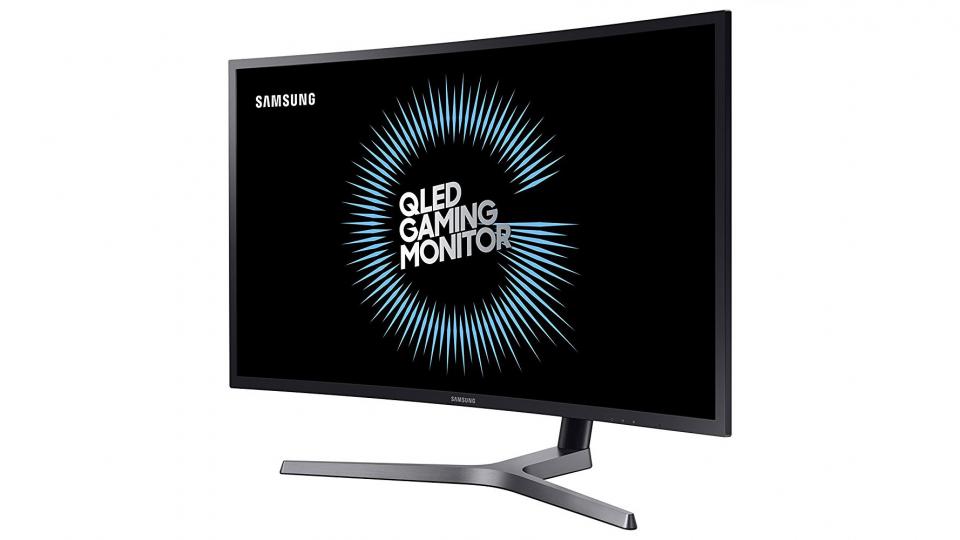
The Samsung CHG70 range included the world’s first HDR gaming monitors. These stunning panels run on a VA panel with Quantum Dot technology to reproduce stunning colours. Up from last year’s C24FG70 144Hz 1080p, and CF791 100Hz 1440p panels, the lineup offers 1440p at 144Hz, the sweet spot for all gamers.
The CHG70 has a 1800R curvature and a fantastic build quality. Its biggest selling point is its HDR support, which provides better colour accuracy, higher contrast ratio and higher brightness levels. With supported PC games or HDR-enabled consoles, the monitor comes to life. With a 1ms MPRT response time and low perceived input lag, the monitor can also be used for competitive gaming. If you’re in the market for one of the best HDR gaming monitors, look no further than the CHG70 line.
Read our full Samsung CHG70 review (C27HG70) for details
Key specs – Screen size: 27in curved; Resolution: 2,560 x 1,440; Screen technology: VA; Video inputs: DisplayPort 1.4, 2 x HDMI 2.0; Refresh rate: 144Hz; Response time: 1ms MPRT
7. Acer Predator XB271HK: The best 4K gaming monitor
Price: £760 | Buy now from Scan
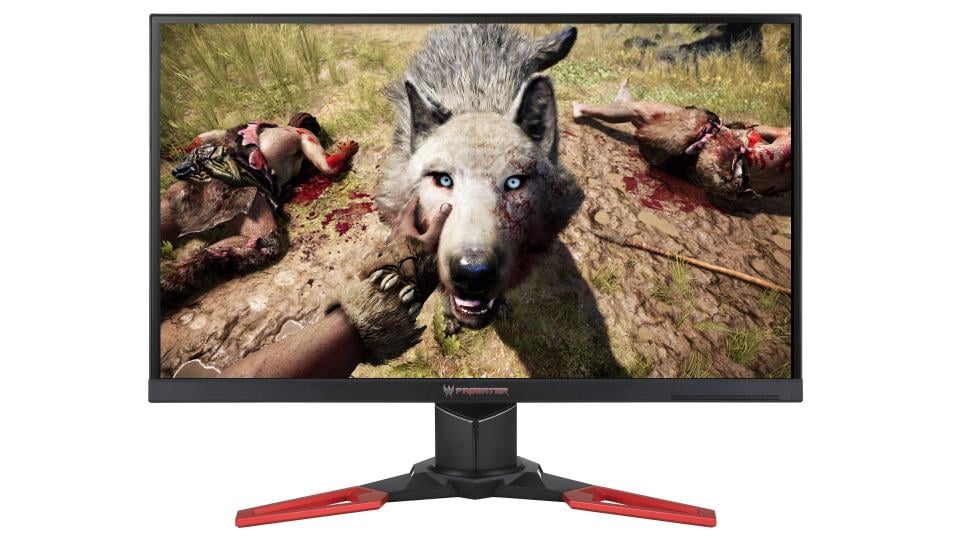
If the Acer Predator XB270HU doesn’t have quite enough pixels for you, Acer’s XB271HK display has a 4K resolution at its disposal, as well as Nvidia’s G-Sync technology, allowing you to pack even more detail into your games. The one thing it doesn’t have is a high refresh rate, sticking with the traditional 60Hz rather than 144Hz.
You’re not missing out on image quality, though: the XB271HK’s stunning IPS panel covers the full sRGB colour gamut out of the box and only needs very mild tweaking to bring its colour temperature into line. It also has more ports than the XB270HU, featuring both HDMI and DisplayPort inputs as well as a USB 3 hub. Add in an adjustable stand and the XB271HK ticks all the right boxes for Ultra HD gaming.
Read our full Acer Predator XB271HK review for details
Key specs – Screen size: 27in; Resolution: 3,840 x 2,160; Screen technology: IPS; Video inputs: DisplayPort 1.2, HDMI 1.4; Refresh rate: 60Hz; Response time: 4ms
8. Philips 436M6VBPAB: The best gaming monitor for console gamers
Price: £472 | Buy now from Scan
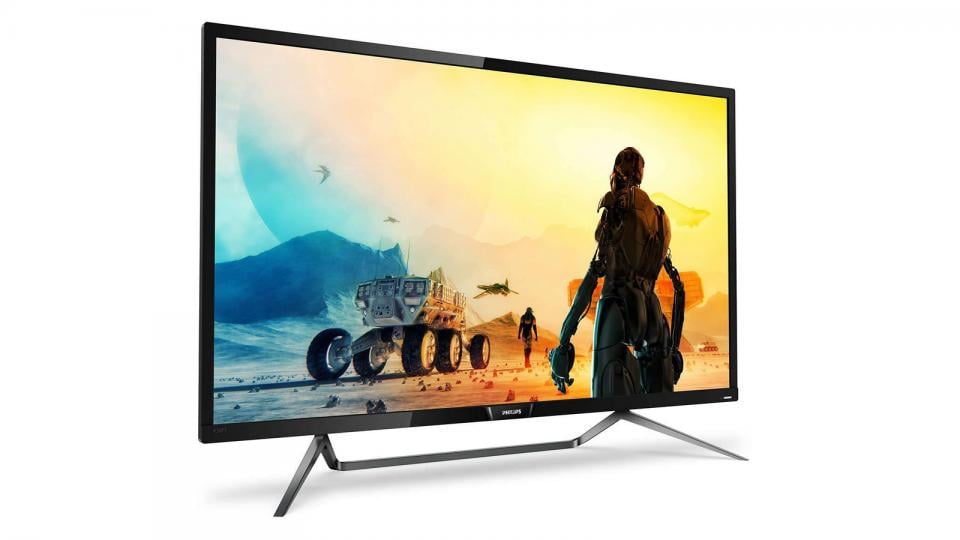
If you want to be gaming on a big screen and love both your PC and console, the Philips 436M6VBPAB is your one-stop ticket to victory. The 43in “monitor” has outstanding HDR capabilities (certified at DisplayHDR 1000 standards), a colour accurate quantum dot MVA panel and runs 4K natively at 60Hz. Around the back, Philips has included its much-loved Ambiglow technology to synchronise the monitor’s LEDs with what you’re seeing on your screen.
It also has a pair of surprisingly good 7W speakers that feature DTS sound. All these features combine to make it the best large-sized panel for console gamers.
Key specs – Screen size: 43in; Resolution: 3,840 x 2,160; Screen technology: MVA; Video inputs: DisplayPort 1.4, HDMI 2.0, mini-DisplayPort 1.4, USB-C (DP Alt mode); Refresh rate: 60Hz; Response time: 4ms
9. LG 34GK950F: The best ultrawide gaming monitor
Price: £1,000 | Buy now from Overclockers UK

The 34GK950F is the ultimate ultrawide gaming monitor. It runs a colour-accurate 34in curved Nano IPS panel with a resolution of 3,440 x 1,440 at 144Hz. It’s also certified to the VESA DisplayHDR 400 standard and has an AMD FreeSync module installed – and, thanks to the new Nvidia drivers, we had no problems running G-Sync, either.
The panel is super-responsive, has perceivably low input lag and doesn’t suffer from any inverse ghosting. It’s suitable for both competitive and casual gaming. No other ultrawide gaming monitor offers an ultra-responsive panel that runs 1440p natively at 144Hz. If the budget permits, get the LG 34GK950F.
Read our full LG 34GK950F review for details
Key specs – Screen size: 34in curved; Resolution: 3,440 x 1,440; Screen technology: IPS; Video inputs: DisplayPort 1.4, 2 x HDMI 2.0; Refresh rate: 144Hz; Response time: 5ms / 1ms MBR
